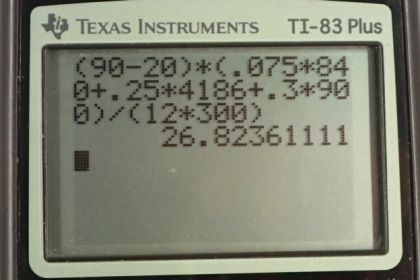Question
What current must be produced by a 12.0-V battery-operated bottle warmer in order to heat 75.0 g of glass, 250 g of baby formula, and of aluminum from to in 5.00 min?
Final Answer
Solution video
OpenStax College Physics for AP® Courses, Chapter 20, Problem 61 (Problems & Exercises)

vote with a rating of
votes with an average rating of
.
Calculator Screenshots
Video Transcript
This is College Physics Answers with Shaun Dychko. We’re going to figure out the current that’s drawn from a 12 Volt battery that’s heating up this baby formula. So, we’re going to write down all of the information that we’re given first of all to keep ourselves organized. So the mass of glass in the bottle for the formula is 75 grams, which we converted to kilograms, 0.075 kilograms. The mass of the formula itself is 250 grams which is 0.25 kilograms. And the mass of Aluminum in this heater is three times ten to the two grams and we’ll convert that into 0.3 kilograms. So we multiply that by the 3.0 times ten to the two grams was multiplied by one kilogram for every 1000 grams. And that works out to point three. And then the time it takes to heat it up is five minutes, which we converted to seconds. Because all of our units should always be meters, kilograms and seconds, M K S units. So we convert the time 5 minutes multiplied by 60 seconds per minute we get 300 seconds. The final temperature will be 90 degrees Celsius and the initial temperature is 20. So, the rate at which energy is being output into this formula is the amount of heat that’s being absorbed by the three things: the glass, formula and Aluminum per time. And the power output of the heater is also the current that it drawn from the battery multiplied by its voltage. And so, we’ll equate this two things. And we say IV equals the heat absorbed and divided by time. And then, we’ll solve this for I by dividing both sides by V. So we have I is Q over Vt. And so the heat absorbed will be mass of the glass multiplied by the specific heat of glass, time and the change in temperature plus the mass of the formula multiplied by its specific heat and all of these are getting multiplied by change in temperature, by the way. So we factor it out right here. And we also have this Aluminum term, mass of the Aluminum multiplied the Aluminum’s specific heat. So this is a Chapter 14 thing if you want to review what that’s about. So, we factor out the change in temperature, multiplied by the product of their respective masses and their specific heats and we divide by voltage times time. So we have 90 degrees Celsius minus 20 degrees Celsius is the change in temperature, multiplied by 0.075 kilograms glass times 840 Joules per kilogram Celsius degree. And this is something I looked up in Chapter 14 of glass. And then we multiply it by 0.25 kilograms times 4,186 Joules per kilogram Celsius degree. We’re going to assume that the formula is mostly water. And so this is the specific heat of water. Then we add to that 0.3 kilograms times 900 Joules per kilogram Celsius degree for Aluminum and divided by 12 Volts times 300 seconds. And that means 26.8 Amps of current that being drawn out of battery.
